If your quads aren’t growing as much as you’d like, the problem probably isn’t how hard you’re training—it’s how smart you’re training.
Many people stick to the same leg exercises no matter which muscles they want to emphasize, but that’s a mistake.
To build bigger quads, you need to prioritize knee-dominant (or “quad-dominant”) exercises—especially those that allow you to lift heavy weights through a full range of motion without putting unnecessary strain on your body.
In this article, you’ll learn the best knee-dominant exercises for building quad mass and strength, why these movements are so effective, and how to turn them into highly effective quad-focused workouts.
Key Takeaways
Knee-dominant exercises primarily train your quads and involve bending your knees through a full range of motion.
The six best knee-dominant exercises for gaining quad mass are front squats, safety-bar squats, Bulgarian split squats, hack squats, step-ups, and sissy squats.
These exercises are so effective because they train your quads through a large range of motion while allowing you to lift heavy weights safely.
Knee-dominant exercises build lower body mass, improve athletic performance, and help reduce injury risk.
While bodyweight knee-dominant exercises can be effective, you’ll need to add progressively heavier weights over time to continue making gains.
What Are Knee-Dominant Exercises?
Knee-dominant exercises are strength training movements where you bend your knees as much as possible and then straighten them again. Since your quads handle most of the workload in these exercises, they’re often called “quad-dominant” exercises.
Knee-dominant exercises stand in contrast to hip-dominant exercises (e.g., deadlifts), which involve less knee bending and rely more on your hips and glutes to move the weight. Here’s an illustration to help you visualize the difference:
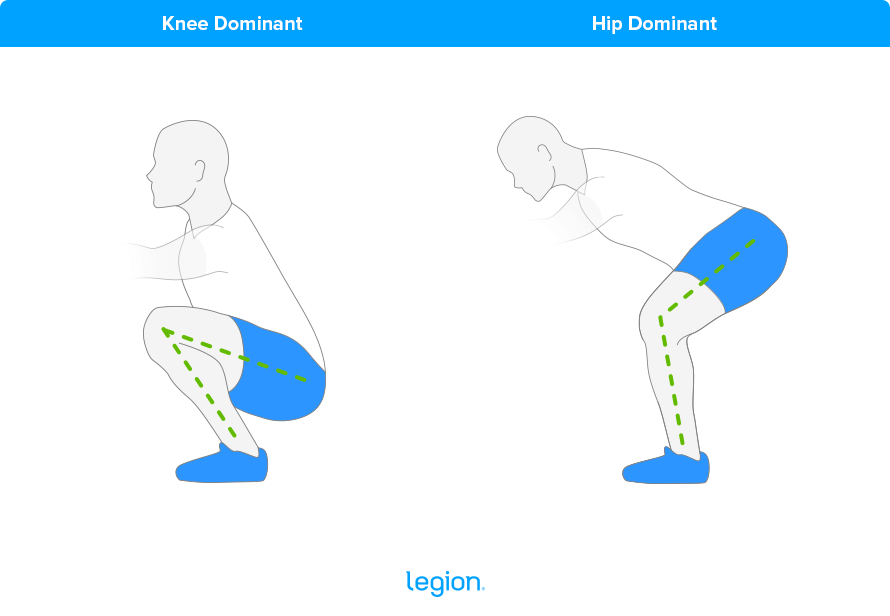
The 6 Best Knee-Dominant Exercises for Quad Mass & Strength
There are many knee-dominant exercises to choose from, but a few stand out as the most effective.
What sets these exercises apart is that they work your quads through a larger range of motion than most lower-body movements, while also allowing you to lift heavy weights safely.
They’re also perfect for applying progressive overload—gradually increasing the weight you lift over time—which is essential for building muscle and strength.
Incorporate these into your quad-focused workouts and watch your quads grow.
1. Front Squat
Most squat variations are knee-dominant exercises, but the front squat is arguably the best for building your quads. Because you place the weight on the front of your body, it allows you to squat deeper, which means your knees bend more and you train your quads through a longer range of motion, both of which are crucial for maximizing growth.
Additionally, the front squat trains your quads just as effectively as the back squat, even when you lift up to 20% less weight. It also reduces strain on your knees and lower back, making it a great option for building quad mass without putting excessive stress on your joints.
READ MORE: How to Front Squat: Form, Benefits & Alternatives
2. Safety-Bar Squat
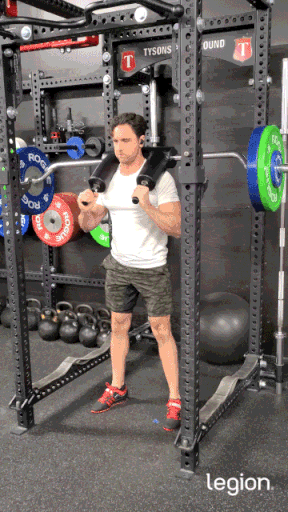

The safety-bar squat is another excellent knee-dominant exercise for building your quads, offering many of the same benefits as the front squat.
The main advantage of the safety-squat bar is that it holds the plates in a slightly offset position compared to a straight barbell, allowing you to maintain a more upright posture. This takes pressure off your lower back and helps you squat deeper, which is essential for maximizing quad growth.
It’s also a great option for anyone with limited upper body mobility or those who find it uncomfortable to rest a barbell on their front or rear delts.
READ MORE: The Safety Bar Squat: How to Use the Safety Squat Bar to Gain Muscle & Strength
3. Bulgarian Split Squat
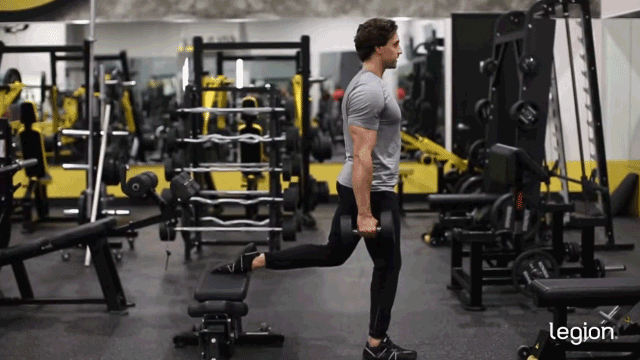

The Bulgarian split squat trains each leg independently, so it helps you build symmetrical lower-body mass.
What’s more, it’s likely better than bilateral knee-dominant exercises (those that train both legs simultaneously) for improving athletic performance. For instance, research from the Shanghai University of Sport shows that single-leg exercises are slightly more effective than bilateral knee-dominant exercises for boosting jumping ability, agility, and speed.
READ MORE: How to Perform Bulgarian Split Squats for Glutes, Hamstrings & Quad Growth
4. Hack Squat
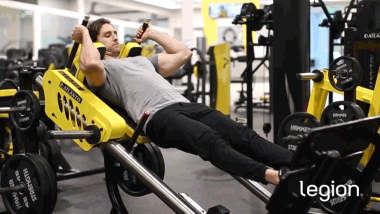

The hack squat is a top-tier quad-dominant exercise for mass because it trains your lower body through a long range of motion without placing stress on your knees and lower back.
Another benefit is that the hack squat doesn’t require much balance or coordination, so it’s great for beginners. It’s also helpful for experienced weightlifters who want to add more volume (sets) to their quad-dominant workouts without the fatigue that comes with more free-weight squatting.
READ MORE: How to Do the Hack Squat: Alternatives, Form, and Benefits
5. Step-up
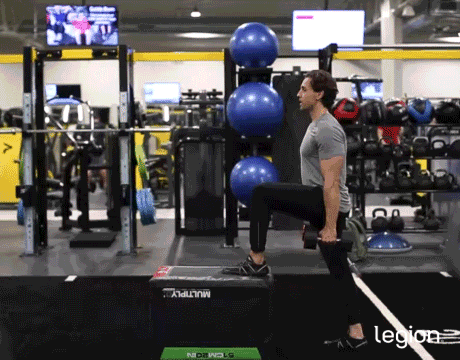

The dumbbell step-up is a solid addition to any quad-dominant leg day because it trains your entire lower body and improves your squat performance while also addressing strength and size imbalances between your legs.
A big advantage of the step-up is that you don’t need to use heavy weights to see results, which makes it easier on your knees and lower back compared to many other lower-body exercises. In other words, it’s a great choice for anyone looking to build their quads without putting excessive strain on their joints.
READ MORE: Weighted Step-Ups Guide: How to Do Dumbbell Step-Ups
6. Sissy Squat
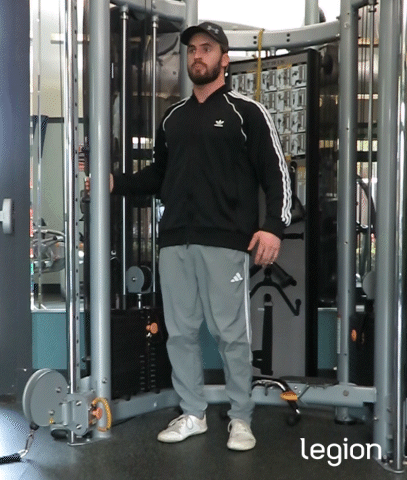

The main advantage of the sissy squat is that it trains your quads through a full range of motion and while fully stretched, which is crucial for maximizing muscle growth.
Although many people consider it a bodyweight exercise, it’s easy to make it more challenging. Once you can do 20 reps per set using just your body weight, simply hold a weight plate or dumbbell to your chest to continue progressing.
READ MORE: How to Do the Sissy Squat: Alternatives, Benefits, and Muscles Worked
An Example Quad-Dominant Leg Day Workout
Here’s a simple quad-dominant workout using the exercises above. Follow this plan for the next 8-to-10 weeks, make sure you’re eating enough calories and protein, and your quads will be bigger, stronger, and more powerful than ever:
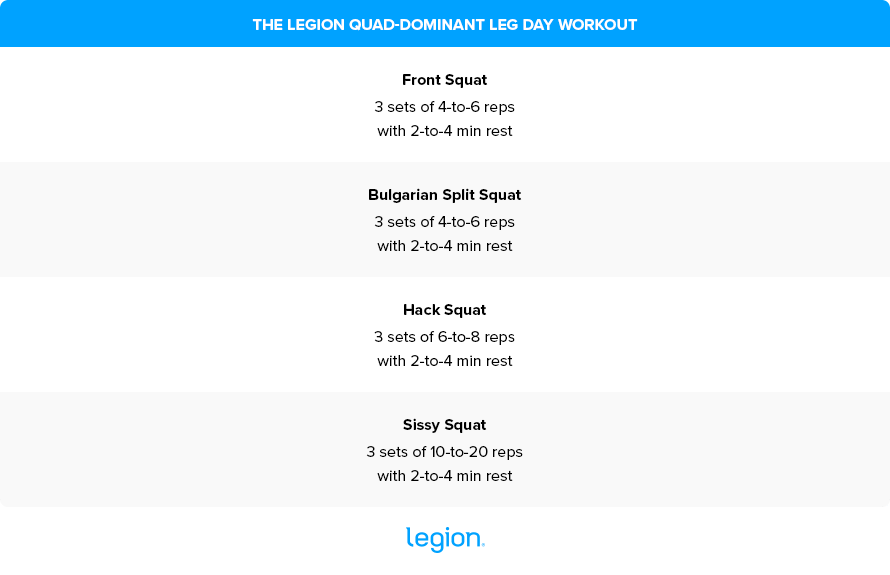

After 8-to-10 weeks of training, take a deload to recover. Once you’re ready to resume hard training, you can either repeat the same quad-dominant leg day workout or create a new routine using the exercises listed above.
Here’s a heuristic you can use to create more effective quad-dominant workouts:
Start with a free-weight barbell squat variation: Front squats and safety-bar squats are excellent choices, but high-bar back squats are a worthy alternative.
Do a unilateral quad-dominant exercise second: Bulgarian split squats and step-ups are great, but lunges and split squats work well, too.
Do a machine knee-dominant exercise third: The hack squat is ideal, but leg presses, belt squats, and pendulum squats are also effective.
Finish with a quad isolation exercise: Sissy squats work best, but leg extensions and reverse Nordic curls are solid alternatives.
FAQ #1: What are the benefits of quad-dominant exercises?
Many new weightlifters (and some experienced ones) prioritize upper body training while neglecting their legs, which often means that their upper bodies dwarf their lower bodies.
Doing quad-dominant exercise helps to balance your upper and lower body, preventing weak points in your physique and performance.
Strong quads also improve athletic performance by increasing power, speed, and strength, which benefits activities like running, jumping, and climbing. Additionally, building your quads enhances lower body stability, reducing the risk of injury.
FAQ #2: Can you do knee-dominant exercise with no equipment?
Yes, bodyweight knee-dominant exercises can be effective, especially if you’re a beginner. Movements like sissy squats and bodyweight Bulgarian split squats and step-ups train your quads without any equipment and can help you build strength initially.
However, as you gain strength, your progress will slow if you don’t make these exercises more difficult. At that point, you’ll either need to incorporate more challenging bodyweight exercises, such as pistol squats, shrimp squats, or reverse Nordic curls, or add extra weight to continue making gains.
FAQ #3: How do you get quad separation?
To get visible quad separation, focus on exercises that target all parts of your quadriceps, particularly knee-dominant compound exercises like front squats, hack squats, and Bulgarian split squats, and quad isolation exercises like sissy squats and leg extensions.
Bear in mind, though, that no matter how developed your quads are, you won’t see separation unless your body fat percentage is low enough. This typically means getting your body fat to around 10% for men or 20% for women.
Achieving this requires a combination of strength training and calorie-controlled dieting. If you want help deciding the best diet and training program for you, take the Legion Diet Quiz and Training Quiz to get a custom-made diet and training plan in less than 60 seconds.
Scientific References +
Yavuz, Hasan Ulas, et al. “Kinematic and EMG Activities during Front and Back Squat Variations in Maximum Loads.” Journal of Sports Sciences, vol. 33, no. 10, 29 Jan. 2015, pp. 1058–1066, www.growkudos.com/publications/10.1080%25252F02640414.2014.984240/reader, https://doi.org/10.1080/02640414.2014.984240.
Gullett, Jonathan C, et al. “A Biomechanical Comparison of Back and Front Squats in Healthy Trained Individuals.” Journal of Strength and Conditioning Research, vol. 23, no. 1, Jan. 2009, pp. 284–292, journals.lww.com/nsca-jscr/fulltext/2009/01000/A_Biomechanical_Comparison_of_Back_and_Front.41.aspx, https://doi.org/10.1519/jsc.0b013e31818546bb.
Meldrum, Richard, and Mark DeBeliso. “A Comparison of Back Squat & Safety Squat Bar on Measures of Strength, Speed, and Power in NCAA Division I Baseball Players.” International Journal of Sports Science, vol. 8, no. 5, 2018, pp. 137–144, article.sapub.org/10.5923.j.sports.20180805.01.html. Accessed 2 Nov. 2019.
Jones, Margaret T, et al. “Effects of Unilateral and Bilateral Lower-Body Heavy Resistance Exercise on Muscle Activity and Testosterone Responses.” Journal of Strength and Conditioning Research, vol. 26, no. 4, Apr. 2012, pp. 1094–1100, https://doi.org/10.1519/jsc.0b013e318248ab3b.
Liao, Kai-Fang , et al. Effects of Unilateral vs. Bilateral Resistance Training Interventions on Measures of Strength, Jump, Linear and Change of Direction Speed: A Systematic Review and Meta-Analysis. 3 July 2021, https://doi.org/10.5114/biolsport.2022.107024.
Deniz Erdağ, and Hasan Ulaş Yavuz. “Evaluation of Muscle Activities during Different Squat Variations Using Electromyography Signals.” ResearchGate, unknown, 2020, www.researchgate.net/publication/337400852_Evaluation_of_Muscle_Activities_During_Different_Squat_Variations_Using_Electromyography_Signals.
Simenz, Christopher J., et al. “Electromyographical Analysis of Lower Extremity Muscle Activation during Variations of the Loaded Step-up Exercise.” Journal of Strength and Conditioning Research, vol. 26, no. 12, Dec. 2012, pp. 3398–3405, https://doi.org/10.1519/jsc.0b013e3182472fad.
Appleby, Brendyn B, et al. “Specificity and Transfer of Lower-Body Strength: Influence of Bilateral or Unilateral Lower-Body Resistance Training.” Journal of Strength and Conditioning Research, vol. 33, no. 2, 2019, pp. 318–326, www.ncbi.nlm.nih.gov/pubmed/30688873, https://doi.org/10.1519/JSC.0000000000002923. Accessed 9 Nov. 2019.
Pedrosa, Gustavo F., et al. “Partial Range of Motion Training Elicits Favorable Improvements in Muscular Adaptations When Carried out at Long Muscle Lengths.” European Journal of Sport Science, vol. 22, no. 8, 23 May 2021, pp. 1250–1260, pubmed.ncbi.nlm.nih.gov/33977835/, https://doi.org/10.1080/17461391.2021.1927199.
Kirkpatrick, John, and Paul Comfort. “Strength, Power, and Speed Qualities in English Junior Elite Rugby League Players.” Journal of Strength and Conditioning Research, vol. 27, no. 9, Sept. 2013, pp. 2414–2419, https://doi.org/10.1519/jsc.0b013e3182804a6d. Accessed 1 Mar. 2019.
Wisloff, U, et al. “Strong Correlation of Maximal Squat Strength with Sprint Performance and Vertical Jump Height in Elite Soccer Players.” British Journal of Sports Medicine, vol. 38, no. 3, 1 June 2004, pp. 285–288, bjsm.bmj.com/content/38/3/285.short.
Seitz, Laurent B., et al. “Increases in Lower-Body Strength Transfer Positively to Sprint Performance: A Systematic Review with Meta-Analysis.” Sports Medicine, vol. 44, no. 12, 25 July 2014, pp. 1693–1702.
Behrens, Matthew J, and Shawn R Simonson. “A Comparison of the Various Methods Used to Enhance Sprint Speed.” Strength and Conditioning Journal, vol. 33, no. 2, Apr. 2011, pp. 64–71, https://doi.org/10.1519/ssc.0b013e318210174d.
Gallego-Izquierdo, Tomás, et al. “Effects of a Gluteal Muscles Specific Exercise Program on the Vertical Jump.” International Journal of Environmental Research and Public Health, vol. 17, no. 15, 1 Jan. 2020, p. 5383, www.mdpi.com/1660-4601/17/15/5383, https://doi.org/10.3390/ijerph17155383. Accessed 14 Dec. 2020.
Bartlett, Jamie L., et al. “Activity and Functions of the Human Gluteal Muscles in Walking, Running, Sprinting, and Climbing.” American Journal of Physical Anthropology, vol. 153, no. 1, 12 Nov. 2013, pp. 124–131, https://doi.org/10.1002/ajpa.22419.
Hartmann, Hagen, et al. “Analysis of the Load on the Knee Joint and Vertebral Column with Changes in Squatting Depth and Weight Load.” Sports Medicine, vol. 43, no. 10, 3 July 2013, pp. 993–1008, www.deepdyve.com/lp/springer-journals/analysis-of-the-load-on-the-knee-joint-and-vertebral-column-with-zkgXYldF90, https://doi.org/10.1007/s40279-013-0073-6.




